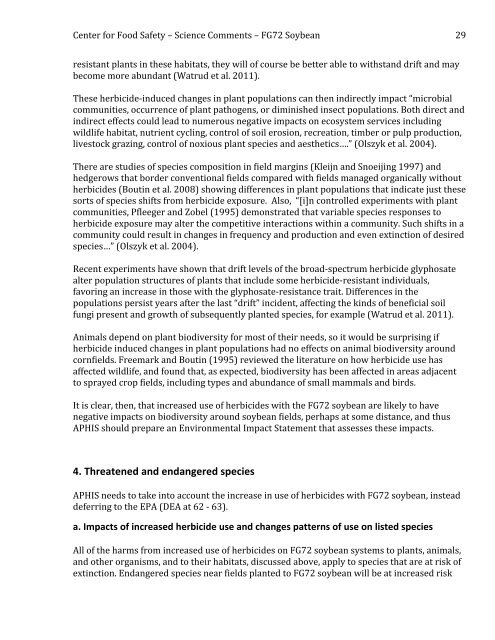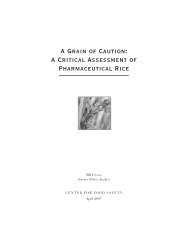a four-fold rise - Center for Food Safety
a four-fold rise - Center for Food Safety
a four-fold rise - Center for Food Safety
Create successful ePaper yourself
Turn your PDF publications into a flip-book with our unique Google optimized e-Paper software.
<strong>Center</strong> <strong>for</strong> <strong>Food</strong> <strong>Safety</strong> – Science Comments – FG72 Soybean <br />
29 <br />
resistant plants in these habitats, they will of course be better able to withstand drift and may <br />
become more abundant (Watrud et al. 2011). <br />
These herbicide-‐induced changes in plant populations can then indirectly impact “microbial <br />
communities, occurrence of plant pathogens, or diminished insect populations. Both direct and <br />
indirect effects could lead to numerous negative impacts on ecosystem services including <br />
wildlife habitat, nutrient cycling, control of soil erosion, recreation, timber or pulp production, <br />
livestock grazing, control of noxious plant species and aesthetics….” (Olszyk et al. 2004). <br />
There are studies of species composition in field margins (Kleijn and Snoeijing 1997) and <br />
hedgerows that border conventional fields compared with fields managed organically without <br />
herbicides (Boutin et al. 2008) showing differences in plant populations that indicate just these <br />
sorts of species shifts from herbicide exposure. Also, “[i]n controlled experiments with plant <br />
communities, Pfleeger and Zobel (1995) demonstrated that variable species responses to <br />
herbicide exposure may alter the competitive interactions within a community. Such shifts in a <br />
community could result in changes in frequency and production and even extinction of desired <br />
species…” (Olszyk et al. 2004). <br />
Recent experiments have shown that drift levels of the broad-‐spectrum herbicide glyphosate <br />
alter population structures of plants that include some herbicide-‐resistant individuals, <br />
favoring an increase in those with the glyphosate-‐resistance trait. Differences in the <br />
populations persist years after the last “drift” incident, affecting the kinds of beneficial soil <br />
fungi present and growth of subsequently planted species, <strong>for</strong> example (Watrud et al. 2011). <br />
Animals depend on plant biodiversity <strong>for</strong> most of their needs, so it would be surprising if <br />
herbicide induced changes in plant populations had no effects on animal biodiversity around <br />
cornfields. Freemark and Boutin (1995) reviewed the literature on how herbicide use has <br />
affected wildlife, and found that, as expected, biodiversity has been affected in areas adjacent <br />
to sprayed crop fields, including types and abundance of small mammals and birds. <br />
It is clear, then, that increased use of herbicides with the FG72 soybean are likely to have <br />
negative impacts on biodiversity around soybean fields, perhaps at some distance, and thus <br />
APHIS should prepare an Environmental Impact Statement that assesses these impacts. <br />
4. Threatened and endangered species <br />
APHIS needs to take into account the increase in use of herbicides with FG72 soybean, instead <br />
deferring to the EPA (DEA at 62 -‐ 63). <br />
a. Impacts of increased herbicide use and changes patterns of use on listed species <br />
All of the harms from increased use of herbicides on FG72 soybean systems to plants, animals, <br />
and other organisms, and to their habitats, discussed above, apply to species that are at risk of <br />
extinction. Endangered species near fields planted to FG72 soybean will be at increased risk







